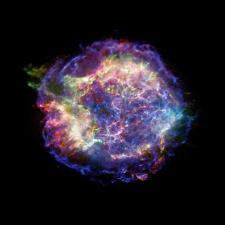Apr 1 2010
Since Galileo first pointed a telescope at the sky 400 years ago, a myriad of technological advances have allowed astronomers to look at very faint objects, very distant objects, and even light that's invisible to the human eye.
 Chandra X-ray Observatory image of the supernova remnant Cassiopeia A (Cas A). The red, green, and blue regions in this X-ray image of Cas A show where the intensity of low, medium, and high-energy X-rays, respectively, is greatest. While this photo shows the remains of the exploded star, light echoes show us reflected light from the explosion itself
Chandra X-ray Observatory image of the supernova remnant Cassiopeia A (Cas A). The red, green, and blue regions in this X-ray image of Cas A show where the intensity of low, medium, and high-energy X-rays, respectively, is greatest. While this photo shows the remains of the exploded star, light echoes show us reflected light from the explosion itself
Yet, one aspect usually remains out of reach - the benefit of a 3-D perspective.
Our telescopes show the Milky Way galaxy only as it appears from one vantage point: our solar system. Now, using a simple but powerful technique, a group of astronomers led by Armin Rest of Harvard University has seen an exploding star or supernova from several angles.
"The same event looks different from different places in the Milky Way," said Rest. "For the first time, we can see a supernova from an alien perspective."
The supernova left behind the gaseous remnant Cassiopeia A. The supernova's light washed over the Earth about 330 years ago. But light that took a longer path, reflecting off clouds of interstellar dust, is just now reaching us. This faint, reflected light is what the astronomers have detected.
The technique is based on the familiar concept of an echo, but applied to light instead of sound. If you yell, "Echo!" in a cave, sound waves bounce off the walls and reflect back to your ears, creating echoes. Similarly, light from the supernova reflects off interstellar dust to the Earth. The dust cloud acts like a mirror, creating light echoes that come from different directions depending on where the clouds are located.
"Just like mirrors in a changing room show you a clothing outfit from all sides, interstellar dust clouds act like mirrors to show us different sides of the supernova," explained Rest.
Moreover, an audible echo is delayed since it takes time for the sound waves to bounce around the cave and back. Light echoes also are delayed by the time it takes for light to travel to the dust and reflect back. As a result, light echoing from the supernova can reach us hundreds of years after the supernova itself has faded away.
Not only do light echoes give astronomers a chance to directly study historical supernovae, they also provide a 3-D perspective since each echo comes from a spot with a different view of the explosion.
Most people think a supernova is like a powerful fireworks blast, expanding outward in a round shell that looks the same from every angle. But by studying the light echoes, the team discovered that one direction in particular looked significantly different than the others.
They found signs of gas from the stellar explosion streaming toward one point at a speed almost 9 million miles per hour (2,500 miles per second) faster than any other observed direction.
"This supernova was two-faced!" said Smithsonian co-author and Clay Fellow Ryan Foley. "In one direction the exploding star was blasted to a much higher speed."
Previous studies support the team's finding. For example, the neutron star created when the star's core collapsed is zooming through space at nearly 800,000 miles per hour in a direction opposite the unique light echo. The explosion may have kicked gas one way and the neutron star out the other side (a consequence of Newton's third law of motion, which states that every action has an equal and opposite reaction).
By combining the new light-echo measurements and the movement of the neutron star with X-ray data on the supernova remnant, astronomers have assembled a 3-D perspective, giving them new insight into the Cas A supernova.
"Now we can connect the dots from the explosion itself, to the supernova's light, to the supernova remnant," said Foley.
Cassiopeia A is located about 16,000 light-years from Earth and contains matter at temperatures of around 50 million degrees F, causing it to glow in X-rays.
The Mayall 4-meter telescope at Kitt Peak National Observatory was used to locate the light echoes. Follow-up spectra were obtained with the 10-meter Keck I Telescope.